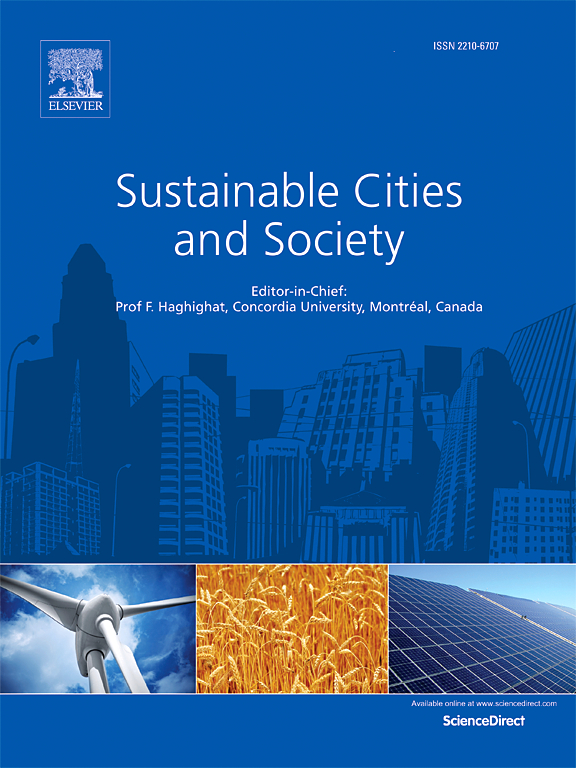Two-stage microgrid resilience and battery life-aware planning and operation for cyclone prone areas in India
IF 10.5
1区 工程技术
Q1 CONSTRUCTION & BUILDING TECHNOLOGY
引用次数: 0
Abstract
Microgrid (MG) resilience is crucial for modern power systems, due to the rising threats from High-Impact Low-Probability (HILP) events, such as natural disasters and cyberattacks. Effective management of microgrid resiliency has become a critical research area, yet operational resiliency studies often overlook microgrid sizing or rely on generic designs rather than actual resource and load data, and rarely incorporate real extreme weather events for performance validation. This paper proposes a two-stage approach for optimal design and resilient operation of the microgrid system. In the first stage, the microgrid’s photovoltaic (PV) arrays, wind turbines (WT), converters, and battery units are sized using HOMER Pro for a coastal village near Ongole, India, based on realistic solar and wind data. In the second stage, a model predictive control-based Mixed Integer Linear Programming (MILP) model with load shifting demand response optimizes real-time operation. An expected resiliency index enables smart control by dynamically adjusting objective function weights and battery state of charge limits, while a novel battery life cycle–depth of discharge formulation enhances battery life expectation. Resiliency is assessed using historical solar and wind data from Cyclone Laila. Simulation results indicate that a 140-kW PV, 80-kW WT, 52-kW converter, and 780 kWh lithium-ion battery system can meet the village’s load demand in both grid-connected and islanded modes during the HILP event. In grid-connected mode, excess energy sales reduce the Cost of Energy to $0.163/kWh, compared to $0.237/kWh in islanded mode. Under resilient operation with demand response, the system delivers an expected battery life of 15.5 years and approaches a resiliency index of close to 1.0. Grid connection doubles battery life while ensuring full load supply during HILP events. Even with reduced planned battery capacity scenarios, the proposed control maintains robust resiliency. These findings indicate that the proposed two-stage framework provides a scalable and sustainable strategy for enhancing MG resilience and battery longevity in regions prone to extreme weather events.
求助全文
约1分钟内获得全文
求助全文
来源期刊

Sustainable Cities and Society
Social Sciences-Geography, Planning and Development
CiteScore
22.00
自引率
13.70%
发文量
810
审稿时长
27 days
期刊介绍:
Sustainable Cities and Society (SCS) is an international journal that focuses on fundamental and applied research to promote environmentally sustainable and socially resilient cities. The journal welcomes cross-cutting, multi-disciplinary research in various areas, including:
1. Smart cities and resilient environments;
2. Alternative/clean energy sources, energy distribution, distributed energy generation, and energy demand reduction/management;
3. Monitoring and improving air quality in built environment and cities (e.g., healthy built environment and air quality management);
4. Energy efficient, low/zero carbon, and green buildings/communities;
5. Climate change mitigation and adaptation in urban environments;
6. Green infrastructure and BMPs;
7. Environmental Footprint accounting and management;
8. Urban agriculture and forestry;
9. ICT, smart grid and intelligent infrastructure;
10. Urban design/planning, regulations, legislation, certification, economics, and policy;
11. Social aspects, impacts and resiliency of cities;
12. Behavior monitoring, analysis and change within urban communities;
13. Health monitoring and improvement;
14. Nexus issues related to sustainable cities and societies;
15. Smart city governance;
16. Decision Support Systems for trade-off and uncertainty analysis for improved management of cities and society;
17. Big data, machine learning, and artificial intelligence applications and case studies;
18. Critical infrastructure protection, including security, privacy, forensics, and reliability issues of cyber-physical systems.
19. Water footprint reduction and urban water distribution, harvesting, treatment, reuse and management;
20. Waste reduction and recycling;
21. Wastewater collection, treatment and recycling;
22. Smart, clean and healthy transportation systems and infrastructure;
 求助内容:
求助内容: 应助结果提醒方式:
应助结果提醒方式:


